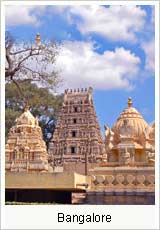Introduction:
The capital of Karnataka state is thriving modern business
center, dubbed the 'Silicon Valley' of India, whose gracious
garrison town features are being remodelled in the image of
India's mall-loving middle class. It likes to think it's more
in tune with Mumbai and Manhattan rather than the rest of
Karnataka, and has been scathingly described as a city ' in
search of a soul '. The pace of life, like the intellectual
and political climate, is brisk. hardly a day goes by without
some new controversy boiling over across the front pages of
it's also regarded as one of India's most progressive and
liberal cities, as far as social attitudes go. Tourist brochures
call Bangalore the 'Garden City', but nothing could be further
from the truth. It's attractions are limited, but it does
have a congenial climate and good transport connections, and
it's a useful place to arrange trips to Karnataka's national
parks and wildlife sanctuaries. If you need a break from life
on the road, it's bars and restaurants can provide some much-needed
light relief. While you are sinking a few beers and munching
on pizza, you can contemplate the pros and cons of modern
India's cionfused but headlong rush into the 21st century.
History:
Bangalore, the 'Garden City Of India' and capital of the State
(1000 m above level ) was founded in 1537 AD by a Vijaynagar
chieftan Kempe Gowda. The legend goes that the King Veera
Ballala of Vijaynagar once lost his way while hunting in a
forest. Hungry tired, he came upon a lone hut in the thick
of forest where he met an old woman. When he asked for food
she gave him some baked beans (Benda Kalu in Kannada ). To
the King this humble meal tasted better than those served
in palace. To commemorate the incident, he called the place
'Benda Kaluooru' (place of baked beans ) and this in time
transformed into Bangalore. In the 18th century it was the
stronghold of Haider Ali and Tipu Sultan. Today it is the
fifth largest city of India and country's main industrial
city which includes industries like aircraft, telephones,
electronics etc.
Sightseeing:
Cubbon Park:
In the heart of the city is the Cubbon Park. This beautiful
300 acre park built by Lieutenant General Sir Mark Cubbon
in 1864 has public library and the museum. The Vidhan Soudha
and many Greco-colonial style buildings of the British era
like the Public Library and the High Court are located here.
Government Museum:
Established in 1896, the Government Museum has on display
ancient weapons, stone carvings, pottery, painting and relics
of the 5000-year-old Mohenjo-Daro civilization.
The Fort and Tipu Sultan's Palace:
Built initially in 1537 by Kempe Gowda as a crude mud structure,
it was rebuilt by Hyder Ali in 1761. In this fort hyder Ali
had imprisoned David Baird along with a number of British
army officers. the fort has well preserved Ganapati temple
within it's precincts and the temple on the outer wall carries
exquisite carvings of Sri Krishna playing his flute and inside,
there is a fine statue of Lord Ganesh which still attracts
devotees. Near the fort is Tipu's palace, begum by Hyder Ali
and completed by Tipu Sultan in 1791. It resembles Daria Daulat
Palace of Srirangapatnam.
Tipu's Summer Palace:
One of Tipu's summer retreats - was begun by Hyder Ali and
completed by Tipu Sultan. It is an elegant two storey wooden
structure with ornate pillars, balconies, arches and a well-maintained
garden.
ISKCON Temple:
The ISKCON Temple was built recently by the International
Society for Krishan Consciousness. As you climb the granite
steps you will encounter three small shrines before the main
temple. The three idols of Lord Krishna in the main shrine
are made of brass.
Vidhana Soudha:
A magnificent post independence structure incorporating the
traditional feature of architecture, the Vidhan Soudha is
located in Cubbon Park. This is an imposing granite structure
with a total plinth area of over 5,00,000 sq.ft and houses
the secretariat, the state legislature and several government
offices. The huge carved doors of the cabinet are made of
pure sandalwood.
Durgah Of Hazrat Tawakkal Mastan Shah Suharawardi:
Situated in the heart of Cottonpet this Muslim saint's shrine
has been associated with the Hindu festival of 'Kangra'. The
famous Kangra procession, while passing through the city,
visits the 'Durgah' of the sufi saint Tawakkal Mastan whose
tomb attracts thousands of both Muslims and non-Muslims.
Gangadhareswara Cave Temple:
Built by Kempe Gowda, this temple with four remarkable monolithic
pillars, is dedicated to Lord Shiva. It also has a rare idol
of Agni, God of fire.
Bull Temple:
At Basavanagudi is one of the oldest temple, typical of the
Dravidian style of architecture. Built by Kempe Gowda, the
Nandi, the sacred bull, carved out of a single boulder, is
6.1 meter long and 4.6 meter high.
Jumma Masjid:
Oldest Mosque built Mughal Killedar, was damaged by cannon
fire during the Mysore war and renovated in 1836.
St Mary's Cathedral:
Built by French missionary in 1882 AD it is a grand Basillica
with an impressive tower and typically gothic pointed arches.
Venkataramanswamy Temple:
Temple near Tipu's palace was built by Chikka Deva Raja Wodeyar
nearly 300 years ago, in the typical Dravidian style. | |
 |

